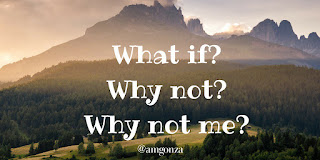Although reflection is crucial to personal or professional growth, one must be careful not to dwell on the past. Whether we are building on successes or learning from our failures, it's important to focus on the road ahead in order to stay on track.
As I reflect on 2015, I feel it was a year of sowing - a year of investment and risk. If you regularly read my blog you know that I am continually reflecting. Whether reflecting on a lesson, a new tool, a setback or a celebration, I'm on a quest to learn from my experiences. In recent posts, I've been deliberately sharing strategies and tools that have worked well (or sometimes not so well) in my classroom. As I read other educators' blogs, I find myself learning from their travels and therefore, I want to reciprocate by sharing my journey as well.
At the end of the school year in June, I wrote "I've Been Wowed" after experimenting with the Wowed app and through it I reflected on all those who have contributed to my professional growth. Back in November, I wrote a post titled "What Have You Done For Me Lately" and again reflected on how my PLN has built me up.
In December, I had an accomplishment that frankly I had only dreamed of. I had the privilege of being published in Education Week. Thanks to my involvement with the Center for Teaching Quality (CTQ), I was asked to contribute and share some insight and therefore wrote "Tips For Connecting With Non-English Speaking Parents". The experience was incredible in many ways. While I am passionate about advocating for ELLs and their families, I love having the opportunity to take my experience from working with this student population and share what I've learned with all teachers. I also have fallen in love with writing and this experience has helped me to hone my skill. Subsequently, I was asked to contribute to other publications. I will be sure to share those as they are published.
Also resulting from my writing experience with the CTQ was the nomination to attend the Elevating and Celebrating Effective Teaching and Teachers (ECET2) Conference in San Diego, California at the end of January 2016. Although the conference is still about four weeks away, I have already connected with some amazing educators at my school, as well as through Twitter and Voxer, who are active in this network of teachers. Stay tuned for an exciting post in early February 2016.
One more celebration was the acceptance of a Student Showcase proposal at NCTIES. On March 3, 2016, several of my high school ELLs and I will take our show on the road as we'll travel to Raleigh, NC. My students will have the opportunity to present their English language accomplishments through blogging to educators across North Carolina and beyond. This is very exciting for my ELLs as it will provide a tremendous leadership opportunity. I look forward to sharing a celebratory post in March.
As I move forward to 2016, I feel that now is the time to reap. I have planted much and will naturally continue to do so, but I feel this a time of harvest. Frankly, I have no idea what the future holds, but I feel some changes are in store. These may be changes in attitude and approach. There may be continued opportunities to share. Changes may be minimal or they may be huge, but I am keeping my options open. Regardless of how it all plays out, I feel that some of the seeds I have planted are ready to bear fruit and I choose to have an optimistic outlook.
In spite of having a fantastic year, I am counting on 2016 being extraordinarily eventful.
Wishing everyone who reads this the #BestYearEver.

















